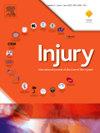The benefit of national clinical guidelines for open lower limb fractures in reducing healthcare burden: A length of inpatient stay cost-analysis
IF 2.2
3区 医学
Q3 CRITICAL CARE MEDICINE
Injury-International Journal of the Care of the Injured
Pub Date : 2025-01-21
DOI:10.1016/j.injury.2025.112178
引用次数: 0
Abstract
Introduction
Severe open lower limb fractures are complex and costly injuries. Studies reporting the costs associated with these injuries, the economic impact of complications, and the clinical benefit of adherence to national guidelines have been previously reported. However, the economic benefits of national guidelines and their relationship with length of inpatient stay have not been described.
Methods
An international retrospective cohort study, using length of stay as a proxy for in-hospital economic impact, comparing the duration of inpatient stay in countries with national guidelines and those without.
Results
In a cohort of 2641 patients from 16 countries, length of stay was 17 % lower in countries with national guidelines, equivalent to 2–3 fewer inpatient days per patient. This difference was primarily driven by a lower incidence of deep infection observed in countries with national clinical guidelines.
Conclusion
The presence of national guidelines for the management of severe lower limb injuries is associated with both improved clinical outcomes and reduced length of stay and therefore healthcare burden. Whilst application and adoption of national guidelines is not without challenges, their implementation is associated with significant clinical and economic benefits.
求助全文
约1分钟内获得全文
求助全文
来源期刊
CiteScore
4.00
自引率
8.00%
发文量
699
审稿时长
96 days
期刊介绍:
Injury was founded in 1969 and is an international journal dealing with all aspects of trauma care and accident surgery. Our primary aim is to facilitate the exchange of ideas, techniques and information among all members of the trauma team.

 求助内容:
求助内容: 应助结果提醒方式:
应助结果提醒方式:


